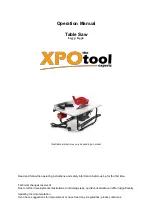
GB/MT
39
9
Use protective equipment
–
Wear protective goggles.
–
Wear a mask when carrying out dust-creating work.
10
Connect the dust extraction device
–
If connections for dust extraction and a collecting de-
vice are present, make sure that they are connected
and used properly.
–
Operation in enclosed areas is only permitted with a
suitable extraction system.
11
Do not use the cable for purposes for which it is not
intended
–
Do not use the cable to pull the plug out of the outlet.
Protect the cable from heat, oil and sharp edges.
12
Secure the workpiece
–
Use the clamping devices or a vice to hold the
workpiece in place. In this manner, it is held more
securely than with your hand.
–
An additional support is necessary for long work-
pieces (table, trestle, etc.) in order to prevent the
machine from tipping over.
–
Always press the workpiece firmly against the work-
ing plate and stop in order to prevent bouncing and
twisting of the workpiece.
13
Avoid abnormal posture
–
Make sure that you have secure footing and always
maintain your balance.
–
Avoid awkward hand positions in which a sudden
slip could cause one or both hands to come into
contact with the saw blade.
14
Take care of your tools
–
Keep cutting tools sharp and clean in order to be
able to work better and more safely.
–
Follow the instructions for lubrication and for tool
replacement.
–
Check the connection cable of the electric tool regu-
larly and have it replaced by a recognised specialist
when damaged.
–
Check extension cables regularly and replace them
when damaged.
–
Keep the handle dry, clean and free of oil and
grease.
15
Pull the plug out of the outlet
–
Never remove loose splinters, chips or jammed wood
pieces from the running saw blade.
–
During non-use of the electric tool or prior to mainte-
nance and when replacing tools such as saw blades,
bits, milling heads.
16
Do not leave a tool key inserted
–
Before switching on, make sure that keys and adjust-
ing tools are removed.
17
Avoid inadvertent starting
–
Make sure that the switch is switched off when plug-
ging the plug into an outlet.
18
Use extension cables for outdoors
–
Only use approved and appropriately identified
extension cables for use outdoors.
–
Only use cable reels in the unrolled state.
19
Remain attentive
–
Pay attention to what you are doing. Remain sensible
when working. Do not use the electric tool when you
are distracted.
20
Check the electric tool for potential damage
–
Protective devices and other parts must be carefully in-
spected to ensure that they are fault-free and function
as intended prior to continued use of the electric tool.
–
Check whether the moving parts function faultlessly
and do not jam or whether parts are damaged. All
parts must be correctly mounted and all conditions
must be fulfilled to ensure fault-free operation of the
electric tool.
–
The moving protective hood may not be fixed in the
open position.
–
Damaged protective devices and parts must be
properly repaired or replaced by a recognised
workshop, insofar as nothing different is specified in
the operating manual.
–
Damaged switches must be replaced at a customer
service workshop.
–
Do not use any faulty or damaged connection cables.
–
Do not use any electric tool on which the switch can-
not be switched on and off.
21
ATTENTION!
–
Exercise elevated caution for double mitre cuts.
22
ATTENTION!
–
The use of other insertion tools and other accessories
can entail a risk of injury.
23
Have your electric tool repaired by a qualified electrician
–
This electric tool conforms to the applicable safety
regulations. Repairs may only be performed by an
electrician using original spare parts. Otherwise ac-
cidents can occur.
Additional safety instructions
1
Safety precautions
–
Warning! Do not use damaged or deformed saw
blades.
–
Replace a worn table insert.
–
Only use saw blades recommended by the manufac-
turer which conform to EN 847-1.
–
Make sure that a suitable saw blade for the material
to be cut is selected.
–
Wear suitable personal protective equipment. This
includes:
–
Hearing protection to avoid the risk of becoming
hearing impaired,
–
Respiratory protection to avoid the risk of inhaling
harmful dust,
–
Wear gloves when handling saw blades and
rough materials. Carry saw blades in a container
whenever practical.
–
Wear goggles. Sparks generated during work
or splinters, chippings and dust coming from the
device can lead to loss of eyesight.
–
Connect a dust collecting device to the electric tool
when sawing wood. The emission of dust is influ-
enced, among other things, by the type of material
to be processed, the significance of local separation
(collection or source) and the correct setting of the
hood/guide plates/guides.
–
Do not use saw blades made of high-speed alloy
steel (HSS steel).
Summary of Contents for PKS 1500 A2
Page 5: ...Fig 5 28 29 6 2 3 27 26 1 34 Fig 4 Fig 5 Fig 7 32 31 Fig 7 Fig 6 30 33 Fig 6...
Page 64: ...59 DE AT CH...
Page 66: ...147 148...
















































